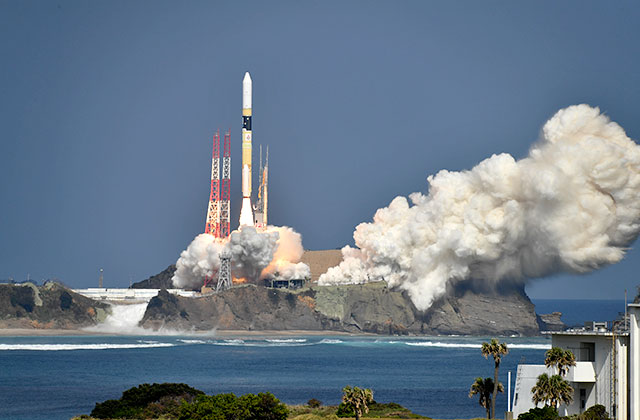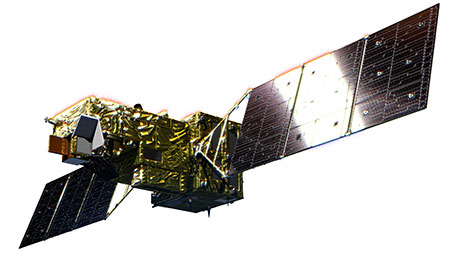About Greenhouse gases Observing SATellite-2 "IBUKI-2" (GOSAT-2)
|
|
Taking over from IBUKI to enhance the functionality and performance of greenhouse gas observations
Experts say that greenhouse gases produced by human activity represent one of the biggest causes of global warming. The Intragovernmental Panel on Climate Change (IPCC), an international organization of specialists that conducts scientific research on climate change and evaluates related climate policies, released its Fifth Assessment Report in 2013. In the document, the authors warned that “Warming of the climate system is unequivocal... It is extremely likely that human influence has been the dominant cause of the observed warming since the mid-20th century... Continued emissions of greenhouse gases will cause further warming and changes in all components of the climate system.”
Hoping to advance research on the global warming phenomenon, JAXA has joined forces with the Ministry of the Environment and the National Institute for Environmental Studies to develop “IBUKI” (GOSAT) - the Greenhouse gases Observing SATellite - and commence GOSAT-based observations of carbon dioxide and methane in 2009. In situ observation of greenhouse gasses on the ground has limitation that many areas are left blank without sufficient observation data due to limited number of the ground observation stations, and that only observation data close to observation points can be acquired though it is highly accurate. On the other hand, satellite observation from top of the atmosphere enables global and comprehensive understanding of greenhouse gasses distribution from their emission sources.
As the successor to the IBUKI mission, "IBUKI-2" (GOSAT-2) aims to gather observations of greenhouse gases with higher levels of accuracy via even higher-performance onboard observation sensors. The project will serve to provide observation data to environmental administrations and drive international anti-global warming efforts.
|
|---|
Oct. 29, 2018 Updated
Successful Launch, H-IIA Launch Vehicle No. 40 Encapsulating "IBUKI-2"(GOSAT-2) and KhalifaSat
|
|
The H-IIA Launch Vehicle No. 40 with the Greenhouse gases Observing SATellite-2 "IBUKI-2"(GOSAT-2) and KhalifaSat, a remote sensing Earth observation satellite onboard lifted off at 13:08:00 p.m. on October 29, 2018 (Japan Standard Time) from the Tanegashima Space Center. The launch and flight of H-IIA F40 proceeded as planned. So did the separation of GOSAT-2 and KhalifaSat, which was confirmed respectively at approximately 16 minutes and 09 seconds and 24 minutes and 15 seconds after lifto...
|
Characteristics of Greenhouse gases Observing SATellite-2 "IBUKI-2" (GOSAT-2)
Global CO2 and CH4 distribution measurements of lower and upper atmosphere with the world highest spectral resolution instrument
GOSAT and GOSAT-2 are only satellites in the world that can observe both absorption of solar reflection from the earth’s surface by the atmosphere and thermal radiation from the atmosphere from the space with its onboard spectrometers with the world highest spectral resolution. These observations provide CO2 and CH4 densities of the lower and upper troposphere and enhance the local emissions. Leveraging these unique features, GOSAT and GOSAT-2 have been acquiring data on concentrations of carbon dioxide (CO2) and methane (CH4), which are the major greenhouse gasses, with their regional differences, seasonal variations and annual increase in upper and lower troposphere.
The IBUKI-2 “eye”: An upgraded IBUKI
GOSAT-2 not only improves in observation accuracy but is equipped with enhanced function that can set the observation points on the ground according to target area to understand emissions and absorptions more accurately. This function enables highly precise and accurate observation of large-scale greenhouse gas emission sources induced by human activities such as power plants, mega cities, oilfields, natural gas fields, landfills and livestock areas.
Besides, GOSAT-2 observes carbon monoxide (CO), which is not included in GOSAT observation target, that is attributable to combustion so that to contribute to environmental administration with CO2 emission source determination.
|
|
| Main observation targets |
Carbon dioxide, methane, carbon monoxide |
|---|
| Onboard instruments |
Thermal And Near Infrared Sensor for carbon Observation - Fourier Transform Spectrometer (TANSO-FTS)
Thermal And Near Infrared Sensor for carbon Observation - Cloud and Aerosol Imager (TANSO-CAI-2) |
|---|
| Size |
5.3m(X) x 2.0m(Y) x 2.8m(Z)
(16.5m(Y))(when expanded in orbit) |
|---|
| Weight |
1,800 kg or less |
|---|
| Generated power |
5,000 W |
|---|
| Design life |
5 years |
|---|
| Altitude |
613km |
|---|
| Launch Vehicle |
H-IIA Launch Vehicle |
|---|
Greenhouse gases Observing SATellite-2 "IBUKI-2" (GOSAT-2)


